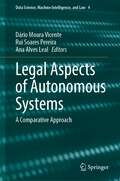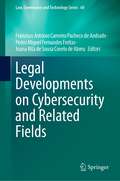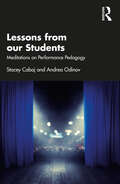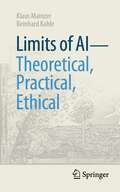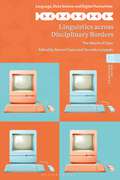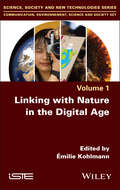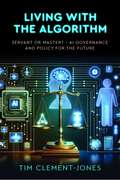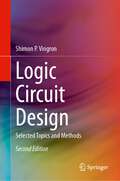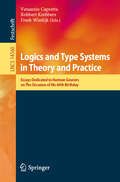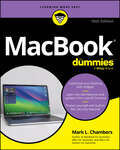- Table View
- List View
Legal Aspects of Autonomous Systems: A Comparative Approach (Data Science, Machine Intelligence, and Law #4)
by Dário Moura Vicente Rui Soares Pereira Ana Alves LealAs computational power, the volume of available data, IT systems’ autonomy, and the human-like capabilities of machines increase, robots and AI systems have substantial and growing implications for the law and raise a host of challenges to current legal doctrines. The main question to be answered is whether the foundations and general principles of private law and criminal law offer a functional and adaptive legal framework for the “autonomous systems” phenomena.The main purpose of this book is to identify and explore possible trajectories for the development of civil and criminal liability; for our understanding of the attribution link to autonomous systems; and, in particular, for the punishment of unlawful conduct in connection with their operation. AI decision-making processes – including judicial sentencing – also warrant close attention in this regard.Since AI is moving faster than the process of regulatory recalibration, this book provides valuable insights on its redesign and on the harmonization, at the European level, of the current regulatory frameworks, in order to keep pace with technological changes.Providing a broader and more comprehensive picture of the legal challenges posed by autonomous systems, this book covers a wide range of topics, including the regulation of autonomous vehicles, data protection and governance, personality rights, intellectual property, corporate governance, and contract conclusion and termination issues arising from automated decisions, blockchain technology and AI applications, particularly in the banking and finance sectors.The authors are legal experts from around the world with extensive academic and/or practical experience in these areas.
Legal Developments on Cybersecurity and Related Fields (Law, Governance and Technology Series #60)
by Francisco António Carneiro Pacheco de Andrade Pedro Miguel Fernandes Freitas Joana Rita de Sousa Covelo de AbreuThis book presents a fresh approach to cybersecurity issues, seeking not only to analyze the legal landscape of the European Union and its Member States, but to do so in an interdisciplinary manner, involving scholars from diverse backgrounds – ranging from legal experts to ICT and engineering professionals.Cybersecurity requirements must be understood in a broader context, encompassing not just conventional aspects, but also emerging topics. This can only be achieved through an interdisciplinary approach. Indeed, cybersecurity should be consistently considered in relation to cybercrime and/or cyber defense, while examining it through the lens of specific domains that are intertwined with various legal fields. Moreover, it is crucial to uphold ethical standards and safeguard fundamental rights, particularly regarding personal data protection.By adopting this comprehensive perspective, the significance of cybersecurity in the exercise of public authority becomes apparent. It also plays an essential role in upholding the fundamental values of both individual Member States and the EU as a whole, such as the rule of law. Moreover, it fosters trust, transparency, and effectiveness in market relations and public administration interactions.In turn, the book draws on the expertise of its authors to provide insights into ICT components and technologies. Understanding these elements holistically is essential to viewing every "cyber" phenomenon from a legal standpoint. In addition to the holistic and interdisciplinary approach it presents, the book offers a captivating exploration of cybersecurity and an engaging read for anyone interested in the field.
Lessons from our Students: Meditations on Performance Pedagogy
by Stacey Cabaj Andrea OdinovLessons from our Students: Meditations on Performance Pedagogy is a collection of thirty short personal case studies about pedagogical issues that arise in theater classrooms and rehearsals. Teaching in the acting and performance classroom is rapidly changing in the early 2020s. In the wake of the global pandemic, online education, massive trauma, and a social justice revolution, educators are seeking wisdom, clarity, and reassurance about their pedagogy. The authors speak to the current moment and the unique challenges of teaching theater by presenting a personal, practical, and authentic expression of vulnerability, humanity, and artistry as teachers. Through thirty personal meditations, the authors pose reflective questions and discussion prompts that evaluate the craft of teaching theater, issues that arise, and ideas about how to respond with vision and integrity. Accompanying exercises invite readers to reflect on their own teaching practices. This book serves as a text for theater teachers and teachers-in-training in search of inspiration, validation, and transformation in drama education and theater pedagogy classes.
Lessons from our Students: Meditations on Performance Pedagogy
by Stacey Cabaj Andrea OdinovLessons from our Students: Meditations on Performance Pedagogy is a collection of thirty short personal case studies about pedagogical issues that arise in theater classrooms and rehearsals. Teaching in the acting and performance classroom is rapidly changing in the early 2020s. In the wake of the global pandemic, online education, massive trauma, and a social justice revolution, educators are seeking wisdom, clarity, and reassurance about their pedagogy. The authors speak to the current moment and the unique challenges of teaching theater by presenting a personal, practical, and authentic expression of vulnerability, humanity, and artistry as teachers. Through thirty personal meditations, the authors pose reflective questions and discussion prompts that evaluate the craft of teaching theater, issues that arise, and ideas about how to respond with vision and integrity. Accompanying exercises invite readers to reflect on their own teaching practices. This book serves as a text for theater teachers and teachers-in-training in search of inspiration, validation, and transformation in drama education and theater pedagogy classes.
Lifelong and Continual Learning Dialogue Systems (Synthesis Lectures on Human Language Technologies)
by Sahisnu Mazumder Bing LiuThis book introduces the new paradigm of lifelong and continual learning dialogue systems to endow dialogue systems with the ability to learn continually by themselves through their own self-initiated interactions with their users and the working environments. The authors present the latest developments and techniques for building such continual learning dialogue systems. The book explains how these developments allow systems to continuously learn new language expressions, lexical and factual knowledge, and conversational skills through interactions and dialogues. Additionally, the book covers techniques to acquire new training examples for learning new tasks during the conversation. The book also reviews existing work on lifelong learning and discusses areas for future research.
Limits of AI - theoretical, practical, ethical (Technik im Fokus)
by Klaus Mainzer Reinhard KahleArtificial intelligence is a key technology with great expectations in science, industry, and everyday life. This book discusses both the perspectives and the limitations of this technology. This concerns the practical, theoretical, and conceptual challenges that AI has to face. In an early phase of symbolic AI, AI focused on formal programs (e.g., expert systems), in which rule-based knowledge was processed with the help of symbolic logic. Today, AI is dominated by statistics-based machine learning methods and Big Data. While this sub-symbolic AI is extremely successful (e.g., chatbots like ChatGPT), it is often not transparent. The book argues for explainable and reliable AI, in which the logical and mathematical foundations of AI-algorithms become understandable and verifiable.
Linear Algebra in Data Science (Compact Textbooks in Mathematics)
by Peter Zizler Roberta La HayeThis textbook explores applications of linear algebra in data science at an introductory level, showing readers how the two are deeply connected. The authors accomplish this by offering exercises that escalate in complexity, many of which incorporate MATLAB. Practice projects appear as well for students to better understand the real-world applications of the material covered in a standard linear algebra course. Some topics covered include singular value decomposition, convolution, frequency filtering, and neural networks. Linear Algebra in Data Science is suitable as a supplement to a standard linear algebra course.
Linguistic Resources for Natural Language Processing: On the Necessity of Using Linguistic Methods to Develop NLP Software
by Max SilberzteinEmpirical — data-driven, neural network-based, probabilistic, and statistical — methods seem to be the modern trend. Recently, OpenAI’s ChatGPT, Google’s Bard and Microsoft’s Sydney chatbots have been garnering a lot of attention for their detailed answers across many knowledge domains. In consequence, most AI researchers are no longer interested in trying to understand what common intelligence is or how intelligent agents construct scenarios to solve various problems. Instead, they now develop systems that extract solutions from massive databases used as cheat sheets. In the same manner, Natural Language Processing (NLP) software that uses training corpora associated with empirical methods are trendy, as most researchers in NLP today use large training corpora, always to the detriment of the development of formalized dictionaries and grammars.Not questioning the intrinsic value of many software applications based on empirical methods, this volume aims at rehabilitating the linguistic approach to NLP. In an introduction, the editor uncovers several limitations and flaws of using training corpora to develop NLP applications, even the simplest ones, such as automatic taggers.The first part of the volume is dedicated to showing how carefully handcrafted linguistic resources could be successfully used to enhance current NLP software applications. The second part presents two representative cases where data-driven approaches cannot be implemented simply because there is not enough data available for low-resource languages. The third part addresses the problem of how to treat multiword units in NLP software, which is arguably the weakest point of NLP applications today but has a simple and elegant linguistic solution.It is the editor's belief that readers interested in Natural Language Processing will appreciate the importance of this volume, both for its questioning of the training corpus-based approaches and for the intrinsic value of the linguistic formalization and the underlying methodology presented.
Linguistics across Disciplinary Borders: The March of Data (Language, Data Science and Digital Humanities)
by Steven Coats and Veronika LaippalaThis volume highlights the ways in which recent developments in corpus linguistics and natural language processing can engage with topics across language studies, humanities and social science disciplines.New approaches have emerged in recent years that blur disciplinary boundaries, facilitated by factors such as the application of computational methods, access to large data sets, and the sharing of code, as well as continual advances in technologies related to data storage, retrieval, and processing. The “march of data” denotes an area at the border region of linguistics, humanities, and social science disciplines, but also the inevitable development of the underlying technologies that drive analysis in these subject areas.Organized into 3 sections, the chapters are connected by the underlying thread of linguistic corpora: how they can be created, how they can shed light on varieties or registers, and how their metadata can be utilized to better understand the internal structure of similar resources. While some chapters in the volume make use of well-established existing corpora, others analyze data from platforms such as YouTube, Twitter or Reddit. The volume provides insight into the diversity of methods, approaches, and corpora that inform our understanding of the “border regions” between the realms of data science, language/linguistics, and social or cultural studies.
Linked Data for Digital Humanities (ISSN)
by Terhi Nurmikko-FullerLinked Data for Digital Humanities provides insights into how digital technologies can enrich and diversify humanities scholarship and make it pioneering in the digital age.Written in non-specialist language, the book illustrates how information is captured, published, represented, accessed, and interpreted using computational systems and, in doing so, shows how technologies actively shape the way we understand what we encounter. Focusing as it does on underlying Web architecture and projects accessible online, the book has an inherently international focus. The interdisciplinary case study examples include bibliographic data from works published in England between 1470 and 1700; literature from ancient Iraq; jazz performances, predominantly from the USA in the 1930s; and even reach as far as an alien, fictional future. Whilst these case study examples span vast spatio-temporal distances, they all share a common thread in the use of the Linked Data information publication paradigm. Using existing computer science methods, as well as processes such as ontology development and database design, the book also includes reflections on practical considerations and offers advice about how to take institutional policies, socio-cultural sensitivities, and economic models into consideration when implementing Linked Data projects.Linked Data for Digital Humanities discusses technological issues in the context of Humanities scholarship, bridging disciplines and enabling informed conversations across disciplinary boundaries. It will be of interest to humanities scholars, computer and data scientists, and library and information scientists.
Linked Data for Digital Humanities (ISSN)
by Terhi Nurmikko-FullerLinked Data for Digital Humanities provides insights into how digital technologies can enrich and diversify humanities scholarship and make it pioneering in the digital age.Written in non-specialist language, the book illustrates how information is captured, published, represented, accessed, and interpreted using computational systems and, in doing so, shows how technologies actively shape the way we understand what we encounter. Focusing as it does on underlying Web architecture and projects accessible online, the book has an inherently international focus. The interdisciplinary case study examples include bibliographic data from works published in England between 1470 and 1700; literature from ancient Iraq; jazz performances, predominantly from the USA in the 1930s; and even reach as far as an alien, fictional future. Whilst these case study examples span vast spatio-temporal distances, they all share a common thread in the use of the Linked Data information publication paradigm. Using existing computer science methods, as well as processes such as ontology development and database design, the book also includes reflections on practical considerations and offers advice about how to take institutional policies, socio-cultural sensitivities, and economic models into consideration when implementing Linked Data projects.Linked Data for Digital Humanities discusses technological issues in the context of Humanities scholarship, bridging disciplines and enabling informed conversations across disciplinary boundaries. It will be of interest to humanities scholars, computer and data scientists, and library and information scientists.
Linking with Nature in the Digital Age
by Émilie KohlmannThe use of digital technology in our societies is growing to meet the ever-increasing challenges of data collection, raising awareness, education and understanding nature. Artificial intelligence, for example, appears to be the answer to collecting massive amounts of data on biodiversity at a global scale and facilitating citizen participation in such data collection. Linking with Nature in the Digital Age explores the reconfiguration of our relationship with nature within this digital framework. This book examines this mediated linking from three angles. Firstly, it shows how digital technology can foster the development of links to nature. Then, it describes in greater detail the materiality of these links and how they have evolved with the developments in information technology. Finally, it questions the belief in the digital as a facilitator and opens up new perspectives on our relationship with nature and the living world
Linking with Nature in the Digital Age
by Émilie KohlmannThe use of digital technology in our societies is growing to meet the ever-increasing challenges of data collection, raising awareness, education and understanding nature. Artificial intelligence, for example, appears to be the answer to collecting massive amounts of data on biodiversity at a global scale and facilitating citizen participation in such data collection. Linking with Nature in the Digital Age explores the reconfiguration of our relationship with nature within this digital framework. This book examines this mediated linking from three angles. Firstly, it shows how digital technology can foster the development of links to nature. Then, it describes in greater detail the materiality of these links and how they have evolved with the developments in information technology. Finally, it questions the belief in the digital as a facilitator and opens up new perspectives on our relationship with nature and the living world
Linux Kernel Programming: A comprehensive and practical guide to kernel internals, writing modules, and kernel synchronization
by Kaiwan N. BillimoriaGain both a firm practical understanding and sufficient theoretical insight into the inner workings of Linux kernel internals, learn to write high-quality kernel module code, understand the complexities of kernel synchronization Purchase of the print or Kindle book includes a free eBook in PDF format.Key FeaturesDiscover how to write Linux kernel and module code for real-world productsImplement industry-grade techniques in real-world scenarios for fast, efficient memory allocation and data synchronizationUnderstand and exploit kernel architecture, CPU scheduling, and kernel synchronization techniquesBook DescriptionThe 2nd Edition of Linux Kernel Programming is an updated, comprehensive guide for new programmers to the Linux kernel. This book uses the recent 6.1 Long-Term Support (LTS) Linux kernel series, which will be maintained until Dec 2026, and also delves into its many new features. Further, the Civil Infrastructure Project has pledged to maintain and support this 6.1 Super LTS (SLTS) kernel right until August 2033, keeping this book valid for years to come! You’ll begin this exciting journey by learning how to build the kernel from source. In a step by step manner, you will then learn how to write your first kernel module by leveraging the kernel’s powerful Loadable Kernel Module (LKM) framework. With this foundation, you will delve into key kernel internals topics including Linux kernel architecture, memory management, and CPU (task) scheduling. You’ll finish with understanding the deep issues of concurrency, and gain insight into how they can be addressed with various synchronization/locking technologies (e.g., mutexes, spinlocks, atomic/refcount operators, rw-spinlocks and even lock-free technologies such as per-CPU and RCU). By the end of this book, you’ll have a much better understanding of the fundamentals of writing the Linux kernel and kernel module code that can straight away be used in real-world projects and products.What you will learnConfigure and build the 6.1 LTS kernel from sourceWrite high-quality modular kernel code (LKM framework) for 6.x kernelsExplore modern Linux kernel architectureGet to grips with key internals details regarding memory management within the kernelUnderstand and work with various dynamic kernel memory alloc/dealloc APIsDiscover key internals aspects regarding CPU scheduling within the kernel, including cgroups v2Gain a deeper understanding of kernel concurrency issuesLearn how to work with key kernel synchronization primitivesWho this book is forThis book is for beginner Linux programmers and developers looking to get started with the Linux kernel, providing a knowledge base to understand required kernel internal topics and overcome frequent and common development issues. A basic understanding of Linux CLI and C programming is assumed.
Living with the Algorithm: AI Governance and Policy for the Future
by Tim Clement-JonesAn authoritative guide to what is needed for AI governance and regulation from expert authors internationally involved in the practical world of AI. This book tackles the question of why AI is a distinct challenge from other technologies and how we should seek to implement innovation-friendly approaches to regulation. It sets out many of the risks to be considered, why regulation is needed, and the form this should take to promote international convergence on AI governance and the responsible deployment of AI. This is a highly readable prescription for AI governance and regulation designed to encourage the technological goals of humanity whilst ensuring that potential risks are mitigated or prevented and, most importantly, that AI remains our servant and does not become our master.
Logic Circuit Design: Selected Topics and Methods
by Shimon P. VingronThe 2nd edition has been thoroughly revised and is intended as a wakeup call in the stagnant and dormant field of switching algebra and logic circuit design. It presents the material in a concise but thorough way. The topics selected are an in-depth presentation of switching algebra, a theory of memory circuits (sometimes called flop flops), a new approach to asynchronous circuits, and a newly added part presenting a unique programming technique (or language) for programmable logic controllers (PLCs). Be ready for the unorthodox and controversial.
Logics and Type Systems in Theory and Practice: Essays Dedicated to Herman Geuvers on The Occasion of His 60th Birthday (Lecture Notes in Computer Science #14560)
by Freek Wiedijk Venanzio Capretta Robbert KrebbersThis Festschrift, dedicated to Herman Geuvers on the occasion of his 60th birthday, contains papers written by many of his closest collaborators. Herman Geuvers is a full professor at Radboud University Nijmegen and holds a part-time professorship at Eindhoven University of Technology. He received his PhD from Radboud University in 1993 and he was promoted to full professor in Computer Assisted Reasoning in 2006. Prof. Geuvers is an internationally renowned researcher in the field of proof assistants, logic in computer science, lambda calculus, and type theory. He has been a steering committee chair of the TYPES and FSCD conferences, chair of related EU Cost Action projects, and program chair or editor of related conferences and special issues in the area of computer science logic. He is a successful, generous and inspiring advisor and educator. He has been director of education and director of research of the Computer Science Institute at Radboud University Nijmegen, and he is currently chair of the examination board of computer science and chair of the board of the Institute for Programming Research and Algorithmics, a Dutch national inter-university research school. The contributions in this volume reflect Prof. Geuvers’ main research interests.
Long-Term Structural Health Monitoring by Remote Sensing and Advanced Machine Learning: A Practical Strategy via Structural Displacements from Synthetic Aperture Radar Images (SpringerBriefs in Applied Sciences and Technology)
by Alireza Entezami Bahareh Behkamal Carlo De MicheleThis book offers an in-depth investigation into the complexities of long-term structural health monitoring (SHM) in civil structures, specifically focusing on the challenges posed by small data and environmental and operational changes (EOCs). Traditional contact-based sensor networks in SHM produce large amounts of data, complicating big data management. In contrast, synthetic aperture radar (SAR)-aided SHM often faces challenges with small datasets and limited displacement data. Additionally, EOCs can mimic the structural damage, resulting in false errors that can critically affect economic and safety issues. Addressing these challenges, this book introduces seven advanced unsupervised learning methods for SHM, combining AI, data sampling, and statistical analysis. These include techniques for managing datasets and addressing EOCs. Methods range from nearest neighbor searching and Hamiltonian Monte Carlo sampling to innovative offline and online learning frameworks, focusing on data augmentation and normalization. Key approaches involve deep autoencoders for data processing and novel algorithms for damage detection. Validated using simulated data from the I-40 Bridge, USA, and real-world data from the Tadcaster Bridge, UK, these methods show promise in addressing SAR-aided SHM challenges, offering practical tools for real-world applications. The book, thereby, presents a comprehensive suite of innovative strategies to advance the field of SHM.
LPI Web Development Essentials Study Guide: Exam 030-100
by Audrey O'SheaPass the LPI Web Development Essentials exam and set yourself up for success at a new web development job In LPI Linux Professional Institute Web Development Essentials Study Guide: Exam 030-100, accomplished IT educator and systems engineer, Audrey O’Shea delivers an easy-to-follow and hands-on roadmap to passing the LPI Web Development Essentials exam and hitting the ground running at a new job as a web developer. In the book, you’ll explore the software development skills, web technologies, HTML, CSS, Node.js, and JavaScript info you need to implement modern applications and solutions in a web environment. You will find: Introductory coverage of SQL, HTML, JavaScript, CSS, and MongoDB A heavy emphasis on real-world job skills, as well as the technologies used every day by web developers in the field Complimentary access to the Sybex interactive online learning environment and test bank, complete with hundreds of practice questions, electronic flashcards, and a searchable glossary of important termsAn essential and practical resource for anyone preparing for the Web Development Essentials certification exam, LPI Linux Professional Institute Web Development Essentials Study Guide: Exam 030-100 is also the ideal book for entry-level software developers seeking knowledge of web development tools and principles.
LPI Web Development Essentials Study Guide: Exam 030-100
by Audrey O'SheaPass the LPI Web Development Essentials exam and set yourself up for success at a new web development job In LPI Linux Professional Institute Web Development Essentials Study Guide: Exam 030-100, accomplished IT educator and systems engineer, Audrey O’Shea delivers an easy-to-follow and hands-on roadmap to passing the LPI Web Development Essentials exam and hitting the ground running at a new job as a web developer. In the book, you’ll explore the software development skills, web technologies, HTML, CSS, Node.js, and JavaScript info you need to implement modern applications and solutions in a web environment. You will find: Introductory coverage of SQL, HTML, JavaScript, CSS, and MongoDB A heavy emphasis on real-world job skills, as well as the technologies used every day by web developers in the field Complimentary access to the Sybex interactive online learning environment and test bank, complete with hundreds of practice questions, electronic flashcards, and a searchable glossary of important termsAn essential and practical resource for anyone preparing for the Web Development Essentials certification exam, LPI Linux Professional Institute Web Development Essentials Study Guide: Exam 030-100 is also the ideal book for entry-level software developers seeking knowledge of web development tools and principles.
The Ludotronics Game Design Methodology: From First Ideas to Spectacular Pitches and Proposals
by J. MartinThis book supports readers to transition to more advanced independent game projects by deepening their understanding of the concept development process. It covers how to make concepts sufficiently viable, ambitious, and innovative to warrant the creation of a polished prototype in preparation of a publisher pitch. The book is divided into six sections. After a brief tutorial (Preliminary Phase), readers embark on a journey along the book’s methodology. They travel through successive conceptual phases (Preparations, Procedures, Processes, and Propositions); advance through levels and action beats in each of these phases; master challenges (conceptual tasks) and overcome level bosses (design decisions) that become successively harder; collect items (fulfilled documentation tasks); and “win” the game by having progressed from a raw, initial idea to a full-fledged, polished game treatment. This book is designed to support junior and senior year BA or MA students in game design programs, as well as novice indie developers and those in the early stages of their game design career.
The Ludotronics Game Design Methodology: From First Ideas to Spectacular Pitches and Proposals
by J. MartinThis book supports readers to transition to more advanced independent game projects by deepening their understanding of the concept development process. It covers how to make concepts sufficiently viable, ambitious, and innovative to warrant the creation of a polished prototype in preparation of a publisher pitch. The book is divided into six sections. After a brief tutorial (Preliminary Phase), readers embark on a journey along the book’s methodology. They travel through successive conceptual phases (Preparations, Procedures, Processes, and Propositions); advance through levels and action beats in each of these phases; master challenges (conceptual tasks) and overcome level bosses (design decisions) that become successively harder; collect items (fulfilled documentation tasks); and “win” the game by having progressed from a raw, initial idea to a full-fledged, polished game treatment. This book is designed to support junior and senior year BA or MA students in game design programs, as well as novice indie developers and those in the early stages of their game design career.
MAC Protocol Design in Full-Duplex Enabled Wireless Networks (Wireless Networks)
by Weihua Zhuang Ning Zhang Wen Wu Liqun Fu Shengbo LiuThis book thoroughly examines the design of full-duplex medium access control (MAC) protocols in wireless networks. It is organized into three main sections: (a) Fundamentals and preliminaries of full-duplex communications, (b) A comprehensive review of the existing full-duplex MAC protocols, and (c) Designs of full-duplex MAC protocols in three typical wireless networks, i.e., wireless local access networks (WLANs), multi-hop networks and millimeter-wave networks. Also, the authors extensively address key challenges in these three wireless full-duplex networks, such as the hidden-node problem, accumulative interference, and deafness and blockage problems. Solutions to these challenges are meticulously devised to enhance the overall network performance. The wireless full-duplex communication technique, facilitating simultaneous transmission and reception within the same frequency band, holds immense potential for enhancing spectrum efficiency and network capacity. It emerges as a pivotal technology in the sixth-generation (6G) networks. This book provides a comprehensive review and in-depth exploration of full-duplex MAC design across various networks, encompassing WLANs, multi-hop networks, and millimeter-wave networks. Acknowledging the challenges faced by full-duplex WLANs, particularly the hidden-node problem, it also introduces a pioneering hidden-node-free design and a MAC protocol design, which features a full-duplex enhanced carrier-sensing mechanism. Addressing the need to augment end-to-end throughput in multi-hop networks employing full-duplex relaying, the authors present an analytical model for end-to-end throughput and propose a multi-hop full-duplex MAC protocol designed to optimize network performance. Furthermore, the exploration extends to full-duplex millimeter-wave networks, delving into issues of deafness and blockage. A directional full-duplex MAC protocol is introduced to enhance network capacity and mitigate blockage problems. This book concludes by outlining prospective research directions within the related fields of study and offers valuable insights for future exploration. This book targets researchers and advanced level students in computer science and electrical engineering. It also caters to professionals engaged in the fields of wireless networks, full-duplex system, protocol design, and network optimization will also buy this book.
MacBook For Dummies
by Mark L. ChambersDiscover the best tips and tricks for using your new Mac laptop For years, MacBook For Dummies has been making it easy to learn new technology. This new edition keeps the easy-to-follow instructions coming. Learn the basics of customizing your Dock and using desktop widgets. Then, figure out how to go on the internet, stream music, send instant messages, and more. Expert author Mark Chambers will show you how to navigate the macOS operating system and personalize your MacBook to your liking. And you'll learn your way around features like Stage Manager, Continuity Camera, SharePlay, and Handoff. Is this your first new computer in a while? MacBook For Dummies gives you the rundown on how to exist without an internal DVD drive. Whether you're a newbie or a Mac veteran looking for insider tips, this is the quick start guide for you. Learn the features and productivity tools from macOS Stay protected by making the most of the built-in Mac security features Organize your life with Mac's multitasking feature, Stage Manager Discover how to stream music, edit videos, and share media content online MacBook beginners and upgraders alike will graduate to power users of the MacBook Pro and MacBook Air models, thanks to this trusted Dummies title.
MacBook For Dummies
by Mark L. ChambersDiscover the best tips and tricks for using your new Mac laptop For years, MacBook For Dummies has been making it easy to learn new technology. This new edition keeps the easy-to-follow instructions coming. Learn the basics of customizing your Dock and using desktop widgets. Then, figure out how to go on the internet, stream music, send instant messages, and more. Expert author Mark Chambers will show you how to navigate the macOS operating system and personalize your MacBook to your liking. And you'll learn your way around features like Stage Manager, Continuity Camera, SharePlay, and Handoff. Is this your first new computer in a while? MacBook For Dummies gives you the rundown on how to exist without an internal DVD drive. Whether you're a newbie or a Mac veteran looking for insider tips, this is the quick start guide for you. Learn the features and productivity tools from macOS Stay protected by making the most of the built-in Mac security features Organize your life with Mac's multitasking feature, Stage Manager Discover how to stream music, edit videos, and share media content online MacBook beginners and upgraders alike will graduate to power users of the MacBook Pro and MacBook Air models, thanks to this trusted Dummies title.
